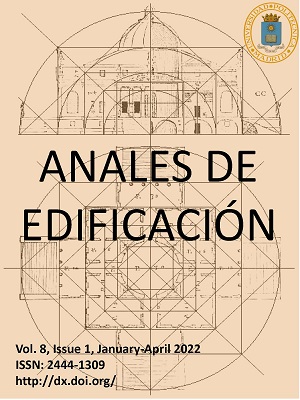Estudio comparativo de estructuras Ligeras en la arquitectura moderna: Eladio Dieste vs Félix Candela = Comparative study of lightweight structures in modern architecture: Eladio Dieste vs. Félix Candela
DOI:
https://doi.org/10.20868/ade.2022.5015Keywords:
Estructuras ligeras, Espesor, Comportamiento mecánico, Estudio comparativo, mecánica de medios continuos, Housing, energy efficiency, thermal loads, design builder, passive systemsAbstract
El siguiente texto presenta el análisis comparativo de las estructuras ligeras del ingeniero uruguayo Eladio Dieste y el Arquitecto español Félix Candela. A través de 4 obras relevantes, como son el restaurante Los Manantiales, la Iglesia Ntra Sra de Guadalupe, La iglesia de San Juan de Ávila y el pabellón del colegio Don Bosco, se comparan aspectos clave en el desarrollo de la arquitectura de ambos y su funcionamiento. A través de las luces, como objetivo principal de las arquitecturas singulares, los soportes y el proceso de ejecución, se pretende extraer las ventajas e inconvenientes de las técnicas constructivas singulares de estos dos genios de la ingeniería del siglo XX, la cerámica estructural y las cáscaras de hormigón. Como principales resultados podemos obtener que el uso de soportes estructurales (pilares) hace que se puedan conseguir alturas mayores que con el uso de las cáscaras de hormigón. En cuanto a los procesos de ejecución, no hay una clara ventaja de uno con respecto a otro, ya que cada uno tiene sus particularidades a la hora de llevarlos a cabo. Las luces conseguidas con las cáscaras de hormigón llegan a ser de casi el doble que, con la cerámica armada, lo cual lo hace adecuado para aquellas edificaciones singulares con necesidad de espacialidad diáfana.
Abstract
The following text presents a comparative analysis of the light structures of the Uruguayan engineer Eladio Dieste and the Spanish architect Félix Candela. Through 4 relevant works, such as the restaurant Los Manantiales, the Church of Our Lady of Guadalupe, the church of San Juan de Ávila and the pavilion of the Don Bosco school, key aspects in the development of the architecture of both and their functioning are compared. By means of the spans, as the main objective of the singular architectures, the supports and the execution process, the aim is to extract the advantages and disadvantages of the singular construction techniques of these two geniuses of 20th century engineering, structural ceramics and concrete shells. The main results are that the use of structural supports (pillars) makes it possible to achieve greater heights than with the use of concrete shells. As for the execution processes, there is no clear advantage of one over the other, as each one has its own particularities when it comes to carrying them out. The spans achieved with concrete shells are almost twice as large as with reinforced ceramics, which makes it suitable for unique buildings with a need for diaphanous spatiality.
Downloads
References
Cabeza Laínez, J. M., & Almodóvar Melendo, J. M. (2000). Las bóvedas de cerámica armada en la obra de Eladio Dieste. Análisis y posibilidades de adaptación a las condiciones constructivas españolas. Retrieved from https://idus.us.es/xmlui/handle/11441/60063
De Bolster, E., Cuypers, H., Van Itterbeeck, P., Wastiels, J., & De Wilde, W. P. (2009). Use of hypar-shell structures with textile reinforced cement matrix composites in lightweight constructions. Composites Science and Technology, 69(9), 1341–1347. https://doi.org/10.1016/J.COMPSCITECH.2008.10.028
Galindo, J., Salazar, C., Henao, L., & Henao, L. (2018a). Cubiertas laminares en cerámica armada: los aportes del ingeniero Guillermo González Zuleta (Colombia, 1947-1962). Informes de La Construcción, 70(551), 270. https://doi.org/10.3989/ic.60713
García, F. L. del B., & Ríos, I. G. (2016). Revista indexada de textos académicos. rita_revista indexada de textos académicos (Vol. 0). Retrieved from http://ojs.redfundamentos.com/index.php/rita/article/view/106
Lávila Arquitectos - Iglesia parroquial de San Juan de Ávila en Alcalá de Henares (en colaboración con Eladio Dieste) | Arquitectos Lavila. (n.d.). Retrieved December 27, 2018.
Martín, A., Ramón, F., & Salazar, F. (n.d.). XVI CONGRESO INTERNACIONAL DE INGENIERÍA GRÁFICA ANÁLISIS GRÁFICO DE OBRAS EMBLEMÁTICAS DE FÉLIX CANDELA. Retrieved from http://www.egrafica.unizar.es/ingegraf/pdf/comunicacion17102.pdf
Martínez, M., & Martínez, M. (2018b). Proceso de cálculo de las cáscaras cilíndricas largas de cubierta en la obra de Félix Candela. El enfoque del equilibrio. Informes de La Construcción, 70(551), 260. https://doi.org/10.3989/ic.56644
Martínez Martínez, M., & Echeverría Valiente, E. (2017). Las bóvedas cilíndricas y su evolución hasta las cáscaras cilíndricas largas de cubierta de Félix Candela. Análisis geométrico y mecanico. EGA Revista de Expresión Gráfica Arquitectónica, 22(30), 160. https://doi.org/10.4995/ega.2017.7846
Mas Guindal, A. J., Adell, J. M., & Adell, J. M. (2005a). Eladio Dieste y la cerámica estructural en Uruguay. Informes de La Construcción, 56(496), 13–23. https://doi.org/10.3989/ic.2005.v57.i496.459 J. M. Blanco, A. Buruaga, E. Rojí, J. Cuadrado, and B. Pelaz, “Energy assessment and optimization of perforated metal sheet double skin façades through Design Builder; A case study in Spain,” Energy Build., vol. 111, pp. 326–336, Jan. 2016, doi: 10.1016/j.enbuild.2015.11.053.
Downloads
Published
Issue
Section
License
Anales de Edificación does not charge authors for processing or publishing an article and provides immediate Open Access to its content. All content is available free of charge to the user or his institution. Users are permitted to read, download, copy, distribute, print, search or link to the full text of articles, or use them for any other lawful purpose, without prior permission from the publisher or author. This is in accordance with the BOAI definition of open access.
- Authors retain the copyright and grant to the journal the right to a Creative Commons attribution / Non-Commercial / Non-Derivative 4.0 International (CC BY NC ND) License that allows others to share the work with an acknowledgement of authorship and non-commercial use.
- Authors may separately establish additional agreements for the non-exclusive distribution of the version of the work published in the journal (for example, placing it in an institutional repository or publishing it in a book).
Unless otherwise indicated, all contents of the electronic edition are distributed under a Creative Commons license.












